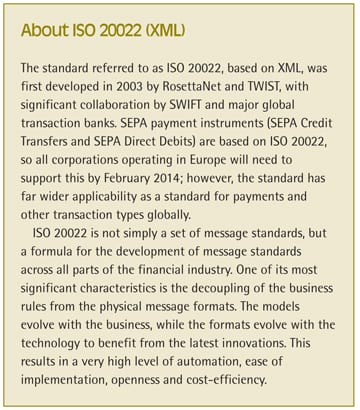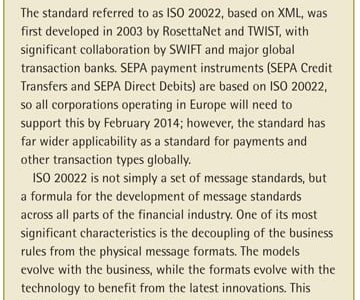by Dieter Stynen, Head of Cash Management Corporates, Western Europe, and Head of Global Transaction Banking Belgium, Deutsche Bank
With the end date for domestic payment instruments in euro only a few months away, all companies should now have completed, or have made considerable progress towards migration to SEPA (Single Euro Payments Area). A vital element of the migration project is the use of XML ISO 20022 formats (XML) on which SEPA payment instruments are based. This article outlines some of the issues that treasurers and finance managers need to consider when implementing XML as part of a SEPA migration project, and the opportunity that XML presents to introduce considerable process efficiencies. These are further enhanced when used in combination with a robust and bank independent communication channel such as SWIFT.
Bank communication channels
Treasurers first need to ensure that their systems support XML, including both the channels with which they communicate with their banks, and that their internal systems, such as ERP, and treasury management systems (TMS) support XML formats. If using SWIFT, or modern electronic banking systems provided by the major banks, whether web-based or host-to-host, this will not be an issue. Systems provided by smaller, local banks, or older versions, may need to be upgraded or replaced. Before XML, proprietary banking systems transmitted and received files and messages in diverse formats, which in some cases has made it difficult to change banks, or the technology used to connect to them. In contrast, XML is a standard format, which better facilitates a harmonised approach to bank connectivity. For example, companies can add or change banks more easily, without the need to amend systems to send or accept files and messages in new formats. Alternatively, the SEPA migration project may also be an opportunity to implement SWIFT connectivity. SWIFT provides bank-neutral, robust, secure connectivity across multiple banking partners, thus further enhancing companies’ bank independence, and supports both XML and other formats.

The value of XML conversion
A more significant technical challenge when introducing XML as part of the SEPA migration is to modify the internal systems that provide or receive information from the banks. These could include one or more ERPs, TMS, payment systems and reconciliation systems. While many vendors of these systems have modified them to support XML in good time for SEPA migration, their customers need to be using up-to-date versions in order to take advantage of this functionality. In the case of ERP, particularly where multiple systems are in use, and systems that are developed in-house, the upgrade process can be an extensive process with significant time, cost and resource implications. In these situations, it may be more realistic to make use of a third party conversion service to ensure SEPA-compliance before the February 2014 end date. These services convert outgoing legacy formats into XML, and incoming XML into formats that can be imported into in-house systems.
Sign up for free to read the full article
Register Login with LinkedInAlready have an account?
Login
Download our Free Treasury App for mobile and tablet to read articles – no log in required.
Download Version Download Version




























